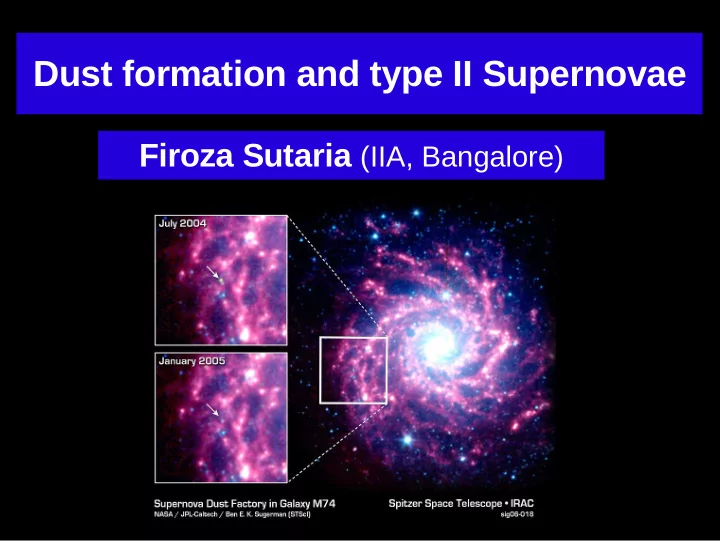

Dust formation and type II Supernovae Firoza Sutaria (IIA, Bangalore)
Core Collapse SNe as dust factories ● Nucleosynthesis & recycling of heavy elements. ● Massive progentiors (M > 8 M ⊙ ) ⇒ Large mass loss (dusty CSM?) + Short lifetimes, + dust production during explosion? Dust from SNe interesting because: ● Source of dust (≥ 10 8 M ⊙) in high z (≥ 6) galaxies? ● If typical M dust ~ 10 -2 M ⊙, w hat is the primordial star formation rate? ● Determining M dust → estimation of M progenitor , + final evolutionary stage: ● Luminous Blue Variable (LBV) (2009ip)? ● Red Super Giant (RSG)? ● Pair instability event (2006gy, 2007bi)?
Dust origins, heating & survival in SNe. Origins: Newly formed? ● Condensed in expanding SN ejecta ● Cool, dense shell between forward and reverse shocks Pre-existing dust from progenitor? Heating mechanisms: ● Radiative heating via reprocessing UV flux – IR light echo possible. ● Collisional heating by hot shocked gas. Survival: Schematic showing the geometry ● Pre-existing dust up to R evap may and interaction of newly formed dust in SN2007od (Inserra et al. 2011). be vaporised via shock heating. R evap = 1 / 2 L peak 4 16 T evap
Observable signatures of dust formation ● IR excess due to thermal emission. ● Increased rate of fading of optical light curve. UBVRI light curves of SN2010jl showing rapid fading in the early light curves (Sutaria et al. 2011) Emission line profile increasingly asymmetric with more absorption in red. (H profiles of SN2010jl; Smith et al. 2011 )
Dust & SNe-II classification SNe-IIn: Narrow emission lines from slow moving CSM (<~ 700 km) intermediate component from decelerated forward shock front (1000 – 5000 km/s), broad component from rapidly expanding SN ejecta (5000 -- 6000 km/s). M dust ~ 10 -3 to 10 -2 M ⊙ . (SN 2010jl) SNe-IIP: Broad emission lines, clear p-cygni progile, large H-envelope, little evidence of clumpy CSM, M dust ~ 10 -4 M ⊙ . (SN2007od) SNe-IIL: Broad emission lines, small H-envelope, very low M dust. SN 1987A: Peculiar type II, small H-envelope, far-IR observations reveal cool dust (~20 K) with M dust ~ 0.4-0.7M ⊙ . Except SN 1987A, all M dust estimated from IR excess. Sampling effect or property of SN-II peculiar?
A Spitzer study of dust in SNe-IIn : ● Over a sample of 68 SN-IIn (10 detections): ● For grain size of 0.01-3.0 m, ● Grain composition of: (a) Amorphous C (b) Silicates ● M dust 10 -5 to 10 -2 M ⊙ ● T dust : 600 to 900 K ● L dust : 10 6 to 10 8 L ⊙ ● IR excess seen for up to > 5000 d after explosion ● IIn may continue to brighten in IR long after fading out optically. Model fits of emission from optically thin, warm (400 – 800 K) dust. (Fox et al. 2011)
Spectral evolution of SN-IIn SN2010jl E IGO data showing spectral evolution of SN2010jl from 16/12/2010 to 27/03/2011 (Sutaria et al, 2011, in preparation). Continuum temp. ~ 7000 K. The narrow emission features are characteristic of Type IIns.
Dust in SN-IIn SN2010jl ● T dust ~ 750K, cool pre-existing dust. ● No evidence for Cool Dense Matter CDM. ● M dust ~ 0.03 – 0.35 M ⊙ , ● CSM mass of 3-35 M ⊙ . ● Geometry: Torus; i=60 to 80 , R in ~ 6 x 10 17 cm, ∆ R ≅ Rin. ● R evap : 6 x 10 16 (C-rich CSM). 3 x 10 17 (O-rich CSM). ● No dust between R in & R evap. SNR 1E0102.2-7219 in N76 ● Dust formed 300-2000 yr before SN. shows the dusty torus likely to ● v dust at time of explosion ~ 100 – 600 km/s. exist in SN2010jl. ● LBV progenitor > 30 M ⊙ . (Andrews et al. 2011)
Conclusions & open questions ● Late time IR emission most likely from pre-existing dust. ● Dust geometry: Shell-like, interior dust evaporates via shock interaction. ● ProgenItors of SN-IIn are most likely LBV. ● SN-IIn largest supernovae contributors of dust? ● Little evidence for cool dense shell. Is most of the dust vaporised? Shock may destroy the dust shell eventually. If so, is the dust in dusty SNRs newly formed? ● Recent observations of SN1987A (with Herschel) resolves the dust deficit?
Recommend
More recommend